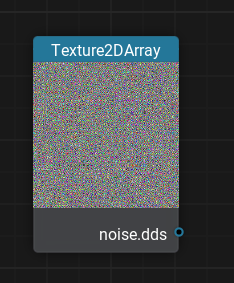Texture 2D Array Node

Description
This node represents almost the same as Texture 2D node, but can contain multiple textures that can be referred to via indices. To sample data from such a texture connect it to the Sample Texture node and specify UV coordinates and a layer Index (starting from 0).
You cannot read intermediate value between two layers of the texture array, for this purpose a Texture 3D should be used.
There is a maximum sampling limit of 16 textures, but using a 2D Texture Array enables you to get around this limitation. If all your textures have the same resolution you can put them all to a single array and read the data as many times as you need using different Sample Texture nodes specifying different layer indices.
The information on this page is valid for UNIGINE 2.19 SDK.